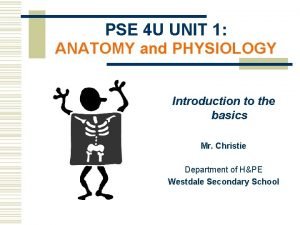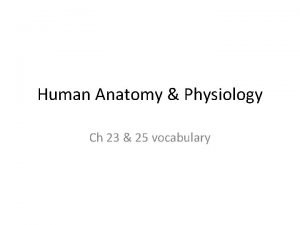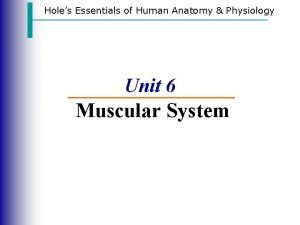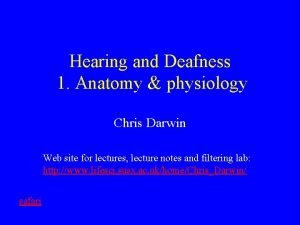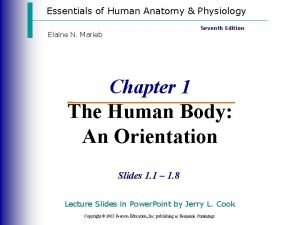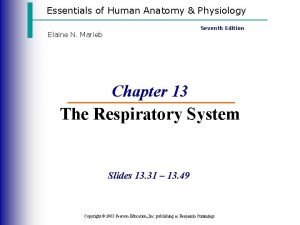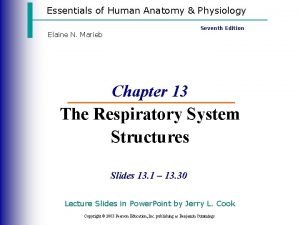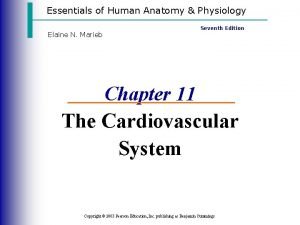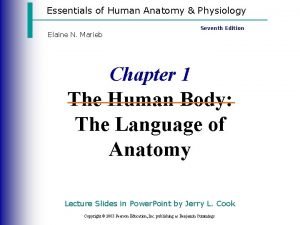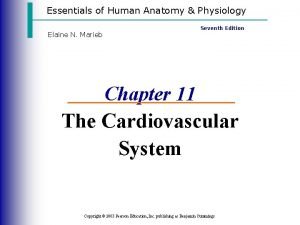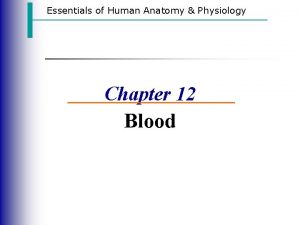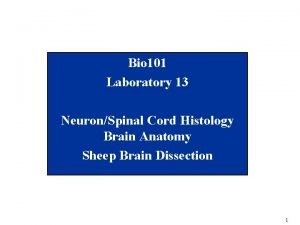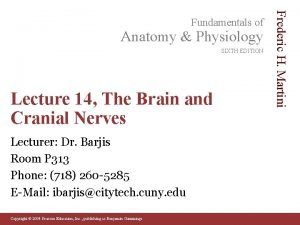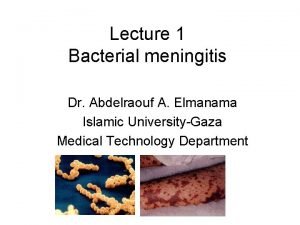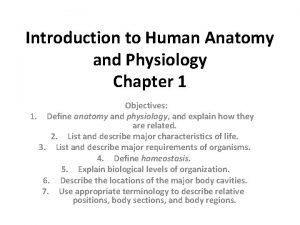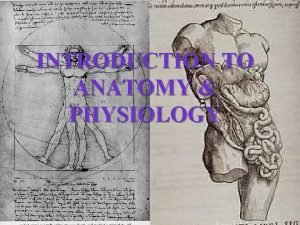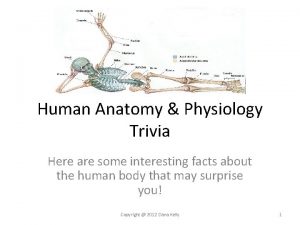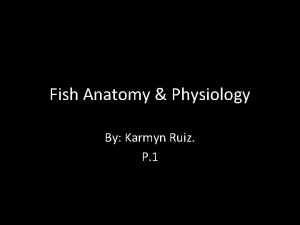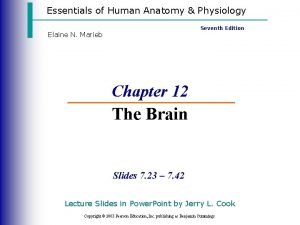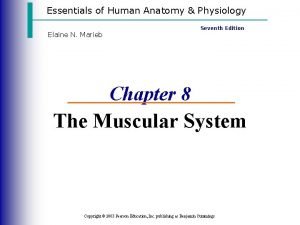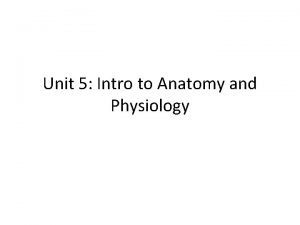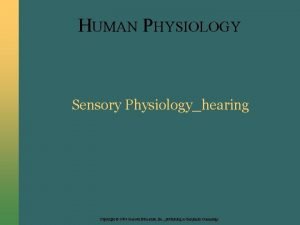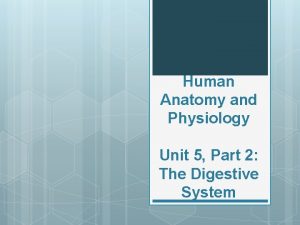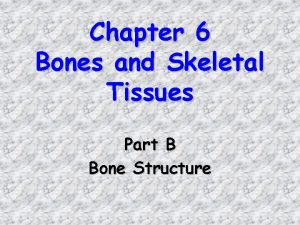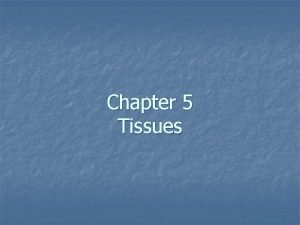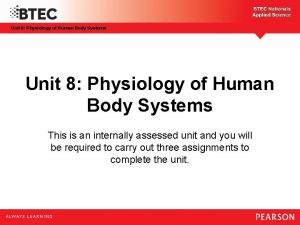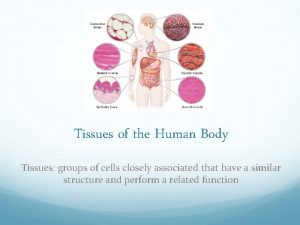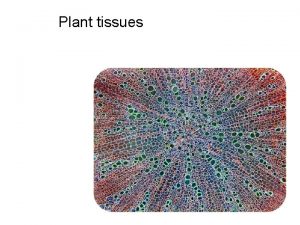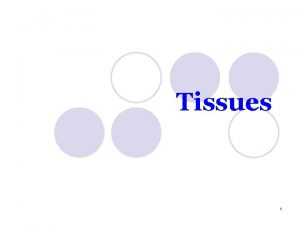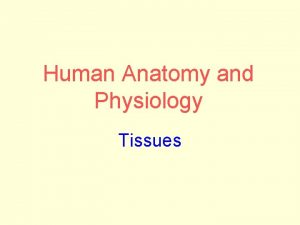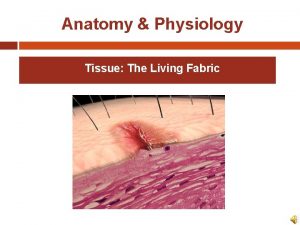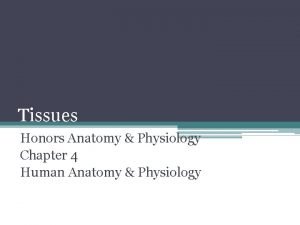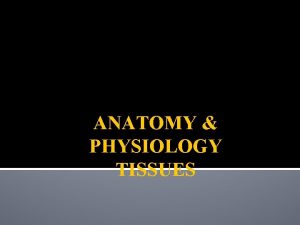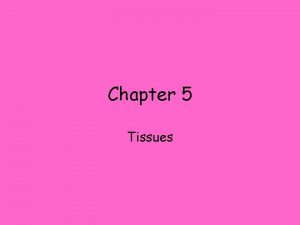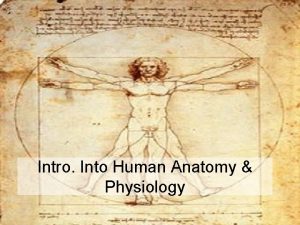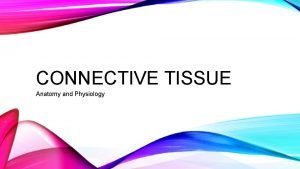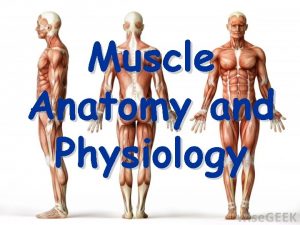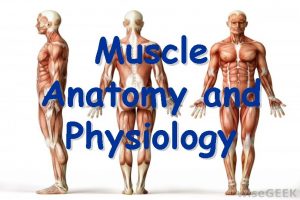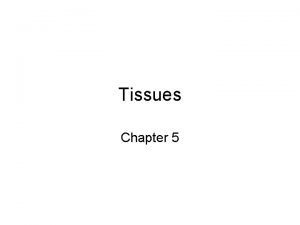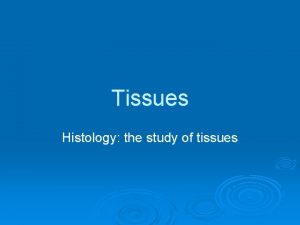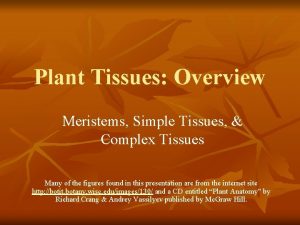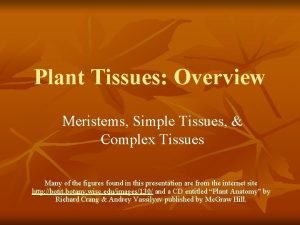Human Tissues Anatomy Physiology Chapter 3 Human Tissue












































































































- Slides: 108

Human Tissues Anatomy & Physiology Chapter 3

Human Tissue n Cells grouped together – Specialized structures and functions – Intercellular Matrix = “glue” n Single layer OR multiple layers n Building block of organs n Cells Tissues Organ

4 Types of Human Tissue n Epithelial n Connective n Muscle n Nervous

Epithelial Tissues n Locations: – Body coverings – Body linings – Glandular tissue n Functions: – Protection – Absorption – Filtration – Secretion © 2015 Pearson Education, Inc.

Epithelial Tissue – Basic Layout

Epithelial Tissue – Basic Layout Outer Surface n Tissue Layer n Basement Membrane n Connective Tissue n

Epithelial Tissue – Basic Layout Outer Surface n Tissue Layer n Basement Membrane n Connective Tissue n

Epithelium Characteristics n Cells fit closely together – often form sheets n Apical surface is free surface n Lower epithelium surface rests on a basement membrane n Avascular (no blood supply) n Regenerate easily if well nourished

Apical surface Basal surface Simple Apical surface Basal surface Stratified (a) Classification based on number of cell laye

Classification and Terminology of Epithelial Tissue LAYERS: n Simple = Single n Stratified = Layers (2 or more!) CELL SHAPE: n Squamous = Squashed, flat cells n Cuboidal = Cube cells n Columnar = Column cells

Apical surface Basal surface Simple Apical surface Basal surface Stratified (a) Classification based on number of cell laye

Squamous Cuboidal Columnar (b) Classification based on cell shape

Structure Shines Light on Function Simple Stratified Pseudostratified (has cilia)

Figure 3. 17 c Classification and functions of epithelia. Number of layers One layer: simple epithelial tissues More than one layer: stratified epithelial tissues Squamous Diffusion and filtration Secretion in serous membranes Protection Cuboidal Secretion and absorption; ciliated types propel mucus or reproductive cells Protection; these tissue types are rare in humans Cell shape Columnar Transitional Protection; stretching to accommodate distension of urinary structures (c) Function of epithelial tissue related to tissue type

Simple Epithelia n Simple squamous – Single layer of flat cells – Location—usually forms membranes • Lines air sacs of the lungs • Forms walls of capillaries • Forms serous membranes (serosae) that line and cover organs in ventral cavity – Functions in diffusion, filtration, or secretion in membranes © 2015 Pearson Education, Inc.

Simple Squamous Epithelium Good For Diffusion Filtration

Figure 3. 18 a Types of epithelia and their common locations in the body. Air sacs of lungs Nucleus of squamous epithelial cell Basement membrane (a) Diagram: Simple squamous Nuclei of squamous epithelial cells Photomicrograph: Simple squamous epithelium forming part of the alveolar (air sac) walls (275×).

Simple Cuboidal Epithelium Good For Secretion Absorption

Simple Epithelia n Simple cuboidal – Single layer of cube-like cells – Locations: • Common in glands and their ducts • Forms walls of kidney tubules • Covers the surface of ovaries – Functions in secretion and absorption; ciliated types propel mucus or reproductive cells © 2015 Pearson Education, Inc.

Figure 3. 18 b Types of epithelia and their common locations in the body. Nucleus of simple cuboidal epithelial cell Basement membrane (b) Diagram: Simple cuboidal epithelial cells Basement membrane Connective tissue Photomicrograph: Simple cuboidal epithelium in kidney tubules (250×).

Simple Columnar Epithelium Good For Absorption Secretion Special Feature: Microvilli

Simple Epithelia n Simple columnar – Single layer of tall cells • Goblet cells secrete mucus – Location: • Lines digestive tract from stomach to anus • Mucous membranes (mucosae) line body cavities opening to the exterior – Functions in secretion and absorption; ciliated types propel mucus or reproductive cells © 2015 Pearson Education, Inc.

Figure 3. 18 c Types of epithelia and their common locations in the body. Nucleus of simple columnar epithelial cell Basement membrane (c) Diagram: Simple columnar Mucus of a goblet cell Simple columnar epithelial cells Basement membrane Photomicrograph: Simple columnar epithelium of the small intestine (575×).

Pseudostratified Columnar Epithelium Good For Protection Secretion Movement Special Feature: Cilia

Simple Epithelia n Pseudostratified columnar – All cells rest on a basement membrane – Single layer, but some cells are shorter than others giving a false (pseudo) impression of stratification – Location: • Respiratory tract, where it is ciliated and known as pseudostratified ciliated columnar epithelium – Functions in absorption or secretion © 2015 Pearson Education, Inc.

Figure 3. 18 d Types of epithelia and their common locations in the body. Cilia Pseudostratified epithelial layer Basement membrane Connective tissue (d) Diagram: Pseudostratified (ciliated) columnar Photomicrograph: Pseudostratified ciliated columnar epithelium lining the human trachea (560×).

Stratified Squamous Epithelium Good For Protection Location: Skin (Epidermis)

Stratified Epithelia n Stratified squamous – Named for cells present at the free (apical) surface, which are flattened – Functions as a protective covering where friction is common – Locations—lining of the: • Skin (outer portion) • Mouth • Esophagus © 2015 Pearson Education, Inc.

Figure 3. 18 e Types of epithelia and their common locations in the body. Nuclei Stratified squamous epithelium Basement membrane (e) Diagram: Stratified squamous epithelium Basement membrane Connective Photomicrograph: tissue Stratified squamous epithelium lining of the esophagus (140×).

Stratified Cuboidal Epithelium Good For Protection

Stratified Columnar Epithelium Good For Protection Secretion

Stratified Epithelia n Stratified cuboidal—two layers of cuboidal cells; functions in protection n Stratified columnar—surface cells are columnar, and cells underneath vary in size and shape; functions in protection n Stratified cuboidal and columnar – Rare in human body – Found mainly in ducts of large glands © 2015 Pearson Education, Inc.

Transitional Epithelium n Specialized Epithelial Tissue – Changes shape under tension n Cuboidal Squamous Cells Example: Urinary Bladder under tension

Stratified Epithelia n Transitional epithelium – Composed of modified stratified squamous epithelium – Shape of cells depends upon the amount of stretching – Functions in stretching and the ability to return to normal shape – Locations: urinary system organs © 2015 Pearson Education, Inc.

Figure 3. 18 f Types of epithelia and their common locations in the body. Transitional epithelium Basement membrane (f) Diagram: Transitional Basement membrane Transitional epithelium Connective tissue Photomicrograph: Transitional epithelium lining of the bladder, relaxed state (270×); surface rounded cells flatten and elongate when the bladder fills with urine.

Glandular Epithelium n Specialized Tissue – makes GLANDS – Secretes substances n 2 Types Exocrine Endocrine Indirect into Duct Direct into fluid/blood Ex. Gall bladder Ex: Adrenal gland n 3 Methods of Secretion (for Exocrine glands)

Glandular Epithelium n Gland – One or more cells responsible for secreting a particular product – Secretions contain protein molecules in an aqueous (water-based) fluid – Secretion is an active process © 2015 Pearson Education, Inc.

Glandular Epithelium n Two major gland types – Endocrine gland • Ductless; secretions diffuse into blood vessels • All secretions are hormones • Examples include thyroid, adrenals, and pituitary © 2015 Pearson Education, Inc.

Glandular Epithelium n Two major gland types – Exocrine gland • Secretions empty through ducts to the epithelial surface • Include sweat and oil glands, liver, and pancreas • Includes both internal and external glands © 2015 Pearson Education, Inc.

Exocrine Gland Secretion n Merocrine gland – Only substance is released. Example: Mucus, salivary gland n Apocrine gland – Lipids and Proteins. – Substance and cell fluid released. Example: some sweat, mammary gland n Holocrine gland – Lipids and Proteins. – Substance and cell is released.


Tissue Identification Activity In 3 rotating groups n Lab tables: view epithelial tissue slides n Desk: Tissue cards – matching game n Desk: Look up description / function

Locations of epithelial tissue


Connective Tissue

Connective Tissue

Connective Tissue n Found everywhere in the body n Includes the most abundant and widely distributed tissues n Functions: – Provides protection – Binds body tissues together – Supports the body © 2015 Pearson Education, Inc.

Connective Tissue Characteristics n Variations in blood supply – Some tissue types are well vascularized – Some have a poor blood supply or are avascular n Extracellular matrix – Nonliving material that surrounds living cells © 2015 Pearson Education, Inc.

Connective Matrix n. A LOT of Intercellular Matrix – Fibers n Located between connective tissue cells

Extracellular Matrix n Two main elements 1. Ground substance—mostly water along with adhesion proteins and polysaccharide molecules 2. Fibers • Produced by the cells • Three types: 1. Collagen (white) fibers 2. Elastic (yellow) fibers 3. Reticular fibers (a type of collagen) © 2015 Pearson Education, Inc.

Connective Cell Types (3) n Fibroblast (with 2 kinds of fibers) – Produces collagenous fibers (thick flexible) – White fibers Example: tendon, ligaments – Produces elastin fibers (thin stretch) – Yellow fibers Example: vocal cords

Connective Cell Types (3) n Macrophage – “Large Eater” – Scavengers – Remove foreign particles from tissue n Mast – Releases heparin (helps blood clot) – Releases histamine (causes inflammation and allergy reaction)

Connective Tissue Types n From most rigid to softest, or most fluid: – Bone – Cartilage – Dense connective tissue – Loose connective tissue – Blood © 2015 Pearson Education, Inc.

Bone Tissue (Connective) Function n Supports n Protects n Provides framework Specialized Cell: Osteocyte

Connective Tissue Types n Bone (osseous tissue) – Composed of: • Osteocytes (bone cells) sitting in lacunae (cavities) • Hard matrix of calcium salts • Large numbers of collagen fibers – Functions to protect and support the body © 2015 Pearson Education, Inc.

Figure 3. 19 a Connective tissues and their common body locations. Bone cells in lacunae Central canal Lacunae Lamella (a) Diagram: Bone Photomicrograph: Cross-sectional view of ground bone (165×)

Cartilage Tissue (Connective) Function n Supports n Protects n Provides framework Some types: n Absorb shock Note: Heals Slowly. Lacks a direct blood supply.

Connective Tissue Types n Cartilage – Less hard and more flexible than bone – Found in only a few places in the body – Chondrocyte (cartilage cell) is the major cell type © 2015 Pearson Education, Inc.

Connective Tissue Types n Hyaline cartilage – Hyaline cartilage is the most widespread type of cartilage • Composed of abundant collagen fibers and a rubbery matrix • Locations: – Larynx – Entire fetal skeleton prior to birth – Epiphyseal plates – Functions as a more flexible skeletal element than bone © 2015 Pearson Education, Inc.

Figure 3. 19 b Connective tissues and their common body locations. Chondrocyte (cartilage cell) Chondrocyte in lacuna Lacunae Matrix (b) Diagram: Hyaline cartilage Photomicrograph: Hyaline cartilage from the trachea (400×)

Connective Tissue Types n Elastic cartilage (not pictured) – Provides elasticity – Location: • Supports the external ear n Fibrocartilage – Highly compressible – Location: • Forms cushionlike discs between vertebrae of the spinal column © 2015 Pearson Education, Inc.

Figure 3. 19 c Connective tissues and their common body locations. Chondrocytes in lacunae Collagen fibers Collagen fiber (c) Diagram: Fibrocartilage Photomicrograph: Fibrocartilage of an intervertebral disc (150×)

Dense Fibrous Connective Tissue Function n Binds organs together

Connective Tissue Types n Dense connective tissue (dense fibrous tissue) – Main matrix element is collagen fiber – Fibroblasts are cells that make fibers – Locations: • Tendons—attach skeletal muscle to bone • Ligaments—attach bone to bone at joints and are more elastic than tendons • Dermis—lower layers of the skin © 2015 Pearson Education, Inc.

Figure 3. 19 d Connective tissues and their common body locations. Ligament Tendon Collagen fibers Nuclei of fibroblasts (d) Diagram: Dense fibrous Photomicrograph: Dense fibrous connective tissue from a tendon (475×)

Loose Fibrous Connective Tissue Areolar Tissue Function n Binds organs together n Holds tissue fluid

Connective Tissue Types n Loose connective tissue types – Areolar tissue • Most widely distributed connective tissue • Soft, pliable tissue like “cobwebs” • Functions as a universal packing tissue and “glue” to hold organs in place • Layer of areolar tissue called lamina propria underlies all membranes • All fiber types form a loose network • Can soak up excess fluid (causes edema) © 2015 Pearson Education, Inc.

Figure 3. 19 e Connective tissues and their common body locations. Mucosa epithelium Lamina propria Elastic fibers Collagen fibers Fibroblast nuclei Fibers of matrix Nuclei of fibroblasts (e) Diagram: Areolar Photomicrograph: Areolar connective tissue, a soft packaging tissue of the body (270×)

Adipose Tissue (Connective) Specialized Loose Fibrous Connective Tissue Function n Protects n Insulates n Stores fat

Connective Tissue Types n Loose connective tissue types – Adipose tissue • Matrix is an areolar tissue in which fat globules predominate • Many cells contain large lipid deposits with nucleus to one side (signet ring cells) • Functions – Insulates the body – Protects some organs – Serves as a site of fuel storage © 2015 Pearson Education, Inc.

Figure 3. 19 f Connective tissues and their common body locations. Nuclei of fat cells Vacuole containing fat droplet (f) Diagram: Adipose Photomicrograph: Adipose tissue from the subcutaneous layer beneath the skin (570×)

Connective Tissue Types n Loose connective tissue types – Reticular connective tissue • Delicate network of interwoven fibers with reticular cells (like fibroblasts) • Locations: – Forms stroma (internal framework) of organs, such as these lymphoid organs: » Lymph nodes » Spleen » Bone marrow © 2015 Pearson Education, Inc.

Figure 3. 19 g Connective tissues and their common body locations. Spleen White blood cell (lymphocyte) Reticular cell Blood cell Reticular fibers (g) Diagram: Reticular Photomicrograph: Dark-staining network of reticular connective tissue (400×)

Blood Tissue (Connective) Function n Transports substances n Helps maintain homeostasis

Connective Tissue Types n Blood (vascular tissue) – Blood cells surrounded by fluid matrix known as blood plasma – Soluble fibers are visible only during clotting – Functions as the transport vehicle for the cardiovascular system, carrying: • Nutrients • Wastes • Respiratory gases © 2015 Pearson Education, Inc.

Figure 3. 19 h Connective tissues and their common body locations. Blood cells in capillary Neutrophil (white blood cell) Red blood cells White blood cell Red blood cells (h) Diagram: Blood Monocyte (white blood cell) Photomicrograph: Smear of human blood (1290×)

Locations of connective tissue

Locations of epithelial and connective tissue



Muscle Tissue Skeletal Muscle Smooth Muscle Cardiac Muscle

Muscle Tissue n Function is to contract, or shorten, to produce movement n Three types: 1. Skeletal muscle 2. Cardiac muscle 3. Smooth muscle © 2015 Pearson Education, Inc.

Muscle Tissue

Skeletal Muscle Tissue Features: n Attached to bone n Conscious control n Activated by nerves n Striated (light/dark stripe appearance)

Muscle Tissue n Function is to contract, or shorten, to produce movement n Three types: 1. Skeletal muscle 2. Cardiac muscle 3. Smooth muscle © 2015 Pearson Education, Inc.

Muscle Tissue Types n Skeletal muscle – Voluntarily (consciously) controlled – Attached to the skeleton and pull on bones or skin – Produces gross body movements or facial expressions – Characteristics of skeletal muscle cells • Striations (stripes) • Multinucleate (more than one nucleus) • Long, cylindrical shape © 2015 Pearson Education, Inc.

Figure 3. 20 a Type of muscle tissue and their common locations in the body. Nuclei Part of muscle fiber (a) Diagram: Skeletal muscle Photomicrograph: Skeletal muscle (195×)

Cardiac Muscle Tissue Features: n Self pulsating n Only in heart n Unconscious control n Activated by nerves n Intercalated disk connect cells

Muscle Tissue Types n Cardiac muscle – Involuntarily controlled – Found only in the heart – Pumps blood through blood vessels – Characteristics of cardiac muscle cells • Striations • Uninucleate, short, branching cells • Intercalated discs contain gap junctions to connect cells together © 2015 Pearson Education, Inc.

Figure 3. 20 b Type of muscle tissue and their common locations in the body. Intercalated discs Nucleus (b) Diagram: Cardiac muscle Photomicrograph: Cardiac muscle (475×)

Smooth Muscle Tissue Features: n Move by peristalsis n Unconscious control n Activated by nerves n No Striations

Muscle Tissue Types n Smooth (visceral) muscle – Involuntarily controlled – Found in walls of hollow organs such as stomach, uterus, and blood vessels – Peristalsis, a wavelike activity, is a typical activity – Characteristics of smooth muscle cells • No visible striations • Uninucleate • Spindle-shaped cells © 2015 Pearson Education, Inc.

Figure 3. 20 c Type of muscle tissue and their common locations in the body. Smooth muscle cell Nuclei (c) Diagram: Smooth muscle Photomicrograph: Sheet of smooth muscle (285×)


Nervous Tissue

Nervous Tissue

Neuron – Nerve Cell Features n Interconnected web n Electrochemical impulse n Special Cells: Neuroglia – Support and bind – Supply nutrients to neurons

Nervous Tissue n Composed of neurons and nerve support cells n Function is to receive and conduct electrochemical impulses to and from body parts – Irritability – Conductivity n Support cells called neuroglia insulate, protect, and support neurons © 2015 Pearson Education, Inc.

Figure 3. 21 Nervous tissue. Brain Nuclei of supporting cells Spinal cord Nuclei of supporting cells Cell body of neuron Neuron processes Diagram: Nervous tissue Photomicrograph: Neurons (320×)


Overview n Tissues are building blocks of organs n Tissues are single or multi-layered n Functions revolve around connecting, protecting, supporting and regulating the body. n Regulating the body includes: Absorption Secretion Filtration Diffusion Making blood cells Controlling Repairing tissue Moving Heating

Summary of Tissues n Figure 3. 22 summarizes the tissue types and functions in the body © 2015 Pearson Education, Inc.

Figure 3. 22 Summary of the major functions and body locations of the four tissue types: epithelial, connective, muscle, and nervous tissues. Nervous tissue: Internal communication • Brain, spinal cord, and nerves Muscle tissue: Contracts to cause movement • Muscles attached to bones (skeletal) • Muscles of heart (cardiac) • Muscles of walls of hollow organs (smooth) Epithelial tissue: Forms boundaries between different environments, protects, secretes, absorbs, filters • Lining of GI tract organs and other hollow organs • Skin surface (epidermis) Connective tissue: Supports, protects, binds other tissues together • Bones • Tendons • Fat and other soft padding tissue

Tissue Repair (Wound Healing) n Tissue repair (wound healing) occurs in two ways: 1. Regeneration • Replacement of destroyed tissue by the same kind of cells 2. Fibrosis • Repair by dense (fibrous) connective tissue (scar tissue) © 2015 Pearson Education, Inc.

Tissue Repair (Wound Healing) n Whether regeneration or fibrosis occurs depends on: 1. Type of tissue damaged 2. Severity of the injury n Clean cuts (incisions) heal more successfully than ragged tears of the tissue © 2015 Pearson Education, Inc.

Events in Tissue Repair n Inflammation – Capillaries become very permeable – Clotting proteins migrate into the area from the bloodstream – A clot walls off the injured area n Granulation tissue forms – Growth of new capillaries – Phagocytes dispose of blood clot and fibroblasts © 2015 Pearson Education, Inc.

Events in Tissue Repair n Regeneration of surface epithelium – Scab detaches – Whether scar is visible or invisible depends on severity of wound © 2015 Pearson Education, Inc.

Regeneration of Tissues n Tissues that regenerate easily – Epithelial tissue (skin and mucous membranes) – Fibrous connective tissues and bone n Tissues that regenerate poorly – Skeletal muscle n Tissues that are replaced largely with scar tissue – Cardiac muscle © 2015 Pearson Education, Inc.
 Body tissue
Body tissue The 4 tissues
The 4 tissues Body tissues chapter 3 cells and tissues
Body tissues chapter 3 cells and tissues Stained cheek cell
Stained cheek cell Cells form tissues. tissues form __________.
Cells form tissues. tissues form __________. Waistline
Waistline Chapter 1 introduction to human anatomy and physiology
Chapter 1 introduction to human anatomy and physiology Chapter 2 human reproductive anatomy and physiology
Chapter 2 human reproductive anatomy and physiology Human anatomy and physiology seventh edition marieb
Human anatomy and physiology seventh edition marieb Holes essential of human anatomy and physiology
Holes essential of human anatomy and physiology Uterus perimetrium
Uterus perimetrium Anatomy and physiology edition 9
Anatomy and physiology edition 9 Chapter 14 anatomy and physiology
Chapter 14 anatomy and physiology Anatomy and physiology chapter 8 special senses
Anatomy and physiology chapter 8 special senses Chapter 13 anatomy and physiology of pregnancy
Chapter 13 anatomy and physiology of pregnancy Chapter 2 basic chemistry anatomy and physiology
Chapter 2 basic chemistry anatomy and physiology Chapter 7:9 lymphatic system
Chapter 7:9 lymphatic system Anatomy and physiology coloring workbook figure 14-1
Anatomy and physiology coloring workbook figure 14-1 Chapter 10 blood anatomy and physiology
Chapter 10 blood anatomy and physiology Anatomy and physiology chapter 15
Anatomy and physiology chapter 15 Anatomy and physiology chapter 1
Anatomy and physiology chapter 1 Holes anatomy and physiology chapter 1
Holes anatomy and physiology chapter 1 Gi tract histology
Gi tract histology Male vs female skeleton pelvis
Male vs female skeleton pelvis Chapter 6 general anatomy and physiology
Chapter 6 general anatomy and physiology Chapter 1 an introduction to anatomy and physiology
Chapter 1 an introduction to anatomy and physiology Type of tissue
Type of tissue Lower respiratory tract
Lower respiratory tract Tattoo anatomy and physiology
Tattoo anatomy and physiology International anatomy olympiad
International anatomy olympiad Woody stem parts
Woody stem parts Bone anatomy and physiology
Bone anatomy and physiology Stomach ulcer
Stomach ulcer Liver physiology and anatomy
Liver physiology and anatomy Epigastric region
Epigastric region Difference between anatomy and physiology
Difference between anatomy and physiology Anatomy and physiology blood
Anatomy and physiology blood Http://anatomy and physiology
Http://anatomy and physiology Anatomy and physiology of appendix
Anatomy and physiology of appendix Aohs foundations of anatomy and physiology 1
Aohs foundations of anatomy and physiology 1 Aohs foundations of anatomy and physiology 2
Aohs foundations of anatomy and physiology 2 Anatomy and physiology of swine
Anatomy and physiology of swine Unit 26 agriscience
Unit 26 agriscience Science olympiad anatomy and physiology 2020 cheat sheet
Science olympiad anatomy and physiology 2020 cheat sheet Liver anatomy and physiology ppt
Liver anatomy and physiology ppt Anatomy and physiology of pancreas in diabetes
Anatomy and physiology of pancreas in diabetes Aohs foundations of anatomy and physiology 1
Aohs foundations of anatomy and physiology 1 Aohs foundations of anatomy and physiology 1
Aohs foundations of anatomy and physiology 1 Anatomy and physiology
Anatomy and physiology Cornell notes for anatomy and physiology
Cornell notes for anatomy and physiology Anatomy and physiology unit 7 cardiovascular system
Anatomy and physiology unit 7 cardiovascular system Anatomy and physiology
Anatomy and physiology Aohs foundations of anatomy and physiology 1
Aohs foundations of anatomy and physiology 1 Aohs foundations of anatomy and physiology 1
Aohs foundations of anatomy and physiology 1 Physiology exam 1
Physiology exam 1 Welcome to anatomy and physiology
Welcome to anatomy and physiology Anatomy and physiology of the foot
Anatomy and physiology of the foot Integumentary system psoriasis
Integumentary system psoriasis Pse 4
Pse 4 Pancreas histology slide
Pancreas histology slide Anatomy and physiology vocabulary
Anatomy and physiology vocabulary Anatomy and physiology
Anatomy and physiology Biceps muscle names
Biceps muscle names Anatomy and physiology
Anatomy and physiology Anatomy and physiology
Anatomy and physiology Anatomy and physiology
Anatomy and physiology Anatomy and physiology
Anatomy and physiology Thyroid anatomy
Thyroid anatomy Dorsifelxion
Dorsifelxion Figure 11-8 arteries
Figure 11-8 arteries Anatomy and physiology
Anatomy and physiology Anatomy and physiology
Anatomy and physiology Figure 10-1 blood
Figure 10-1 blood Label o
Label o Anatomy and physiology of the eye
Anatomy and physiology of the eye Cranial nuclei
Cranial nuclei Irn.org anatomy and physiology
Irn.org anatomy and physiology Anatomy and physiology body parts
Anatomy and physiology body parts Unit 26 animal anatomy physiology and nutrition
Unit 26 animal anatomy physiology and nutrition Figure 14-1 digestive system
Figure 14-1 digestive system Anatomy and physiology of the retina
Anatomy and physiology of the retina Animal tissue
Animal tissue Anatomy and physiology of meningitis ppt
Anatomy and physiology of meningitis ppt Jeopardy anatomy and physiology game
Jeopardy anatomy and physiology game Homeostasis definition
Homeostasis definition Anatomy and physiology
Anatomy and physiology Respiratory system in humans
Respiratory system in humans Anatomy and physiology trivia
Anatomy and physiology trivia Fish anatomy and physiology
Fish anatomy and physiology Transverse fissure
Transverse fissure Anatomy and physiology
Anatomy and physiology Unit 5 anatomy and physiology
Unit 5 anatomy and physiology 2012 pearson education inc anatomy and physiology
2012 pearson education inc anatomy and physiology Fundus
Fundus Fish anatomy and physiology
Fish anatomy and physiology Cengage anatomy and physiology
Cengage anatomy and physiology Genetic effects on gene expression across human tissues
Genetic effects on gene expression across human tissues Jaringan epitel dapat ditemukan di
Jaringan epitel dapat ditemukan di Chapter 6 bones and skeletal tissues
Chapter 6 bones and skeletal tissues Chapter 3 cells and tissues
Chapter 3 cells and tissues Chapter 3 cells and tissues figure 3-1
Chapter 3 cells and tissues figure 3-1 Chapter 5 tissues
Chapter 5 tissues Chapter 3 cells and tissues figure 3-1
Chapter 3 cells and tissues figure 3-1 Areolar tissue cell types
Areolar tissue cell types Unit 8 physiology of human body systems assignment 1
Unit 8 physiology of human body systems assignment 1 Specialized connective tissue
Specialized connective tissue Http://www.biologycorner.com/anatomy/histology/
Http://www.biologycorner.com/anatomy/histology/ Laboratory requirements for plant tissue culture ppt
Laboratory requirements for plant tissue culture ppt 3 tissues of a plant
3 tissues of a plant


























































